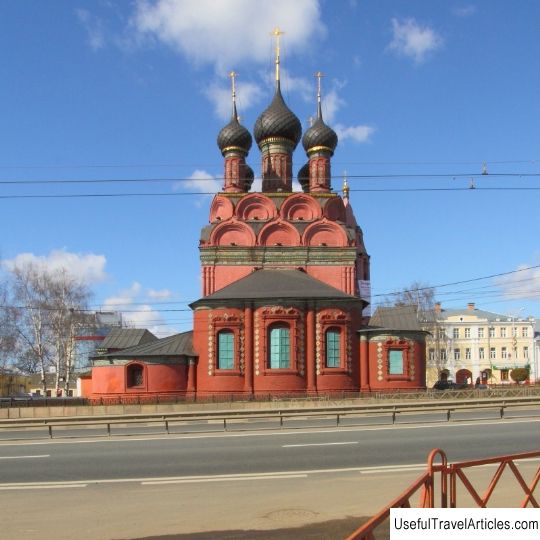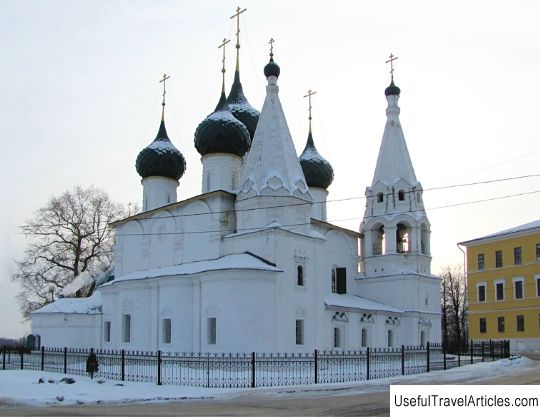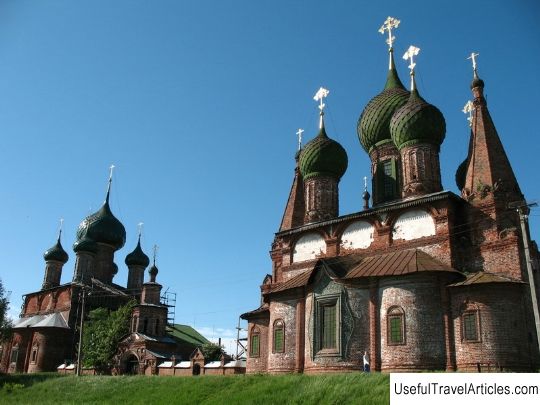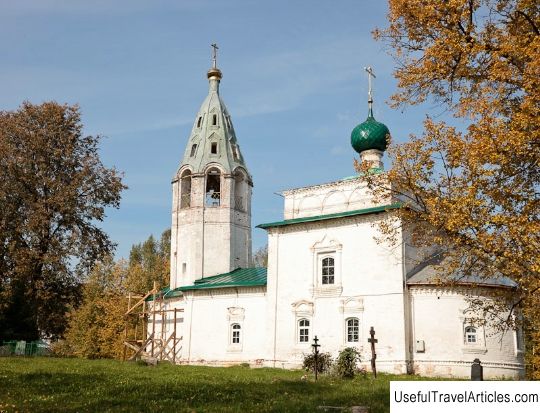Church of Elijah the Prophet description and photo - Russia - Golden Ring: Yaroslavl
Rating: 7,7/10 (1090 votes) 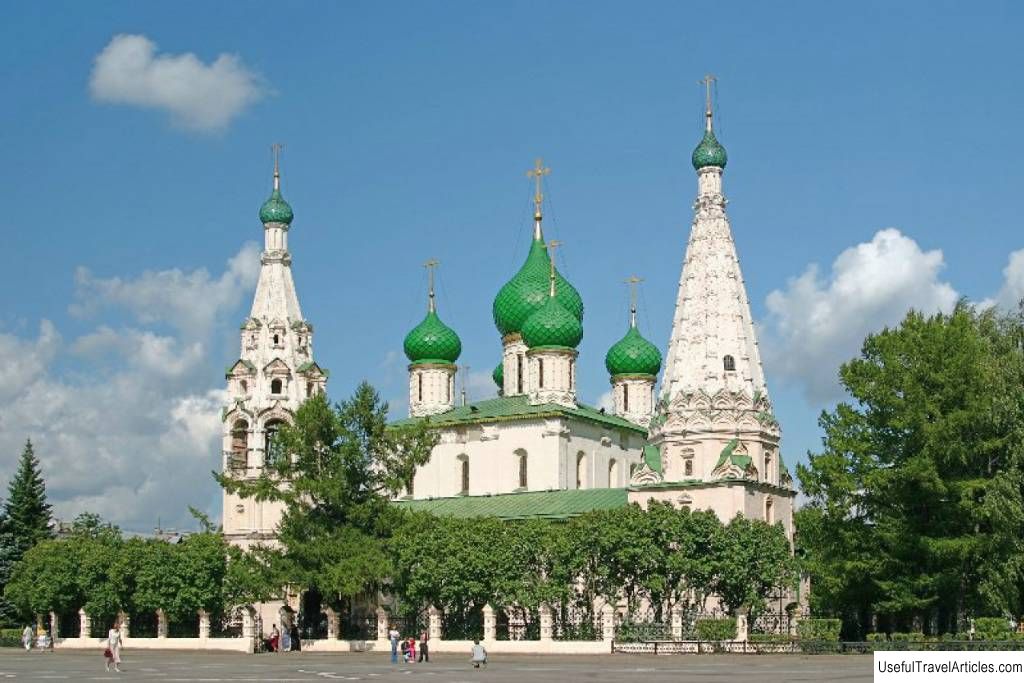
Church of Elijah the Prophet description and photos - Russia - Golden Ring: Yaroslavl. Detailed information about the attraction. Description, photos and a map showing the nearest significant objects. Photo and descriptionElias Church is located in the very center of Yaroslavl. This is one of the most remarkable architectural monuments of the 17th century, which has preserved unique paintings of that time. It is believed that this church is the very first temple in Yaroslavl. A city legend says that there were many bears in the vicinity. This is confirmed by toponymy: the river, at the confluence of which into Kotorosl, the first settlement arose here, is called Medveditsa, and the settlement itself was called Bear's Corner . One of the bears especially bothered the inhabitants, and then the prince Yaroslav the Wise , the founder of the city, arranged a hunt and killed him. It happened on the day of Elijah the Prophet, and in memory of this the church of St. Ilya. However, the first mention of the temple in written sources dates back to 1612 and is associated with the revered icon of the Yaroslavl Savior. When this icon was carried in a procession of the cross past the Church of Elijah the Prophet, a blind boy was healed here. Brothers of the SkripinsThe Elias Church was located in the very center of the city, and was loved by the merchant class. Soon, another church was built nearby - the warm Pokrovskaya, and in 1647-1650, when both were dilapidated, the present building arose. The Skripin brothers, Bonifatius and Anikey (Ioanniki) donated money for this construction. The Skripins family is the richest and most famous family of the townspeople trading people of Yaroslavl in the 17th century. They moved here from Novgorod after it was ravaged by Ivan the Terrible. Skripins got rich on the trade with Siberia - it was through them that all the fur trade and Siberian gold went. For their church, they received a shrine - a particle of the Lord's Robe from the one that was kept in Moscow. It was given to them by Patriarch Joseph. For her, a separate tent-roofed Rizpolozhensky chapel was added to the church, in which this shrine was kept in a rich silver shrine. The most famous icon painters were invited to paint the church - it was Guria Nikitin's artel . The elder brother Bonifatius died by 1680 and the work was completed under his widow Ulita Markovna. The outer walls of the church were also painted with ornaments - herbs and flowers, unfortunately, nothing remained of this painting. However, after many renovations, only the "Crucifixion" on the west porch has survived. The richest carved decoration of windows and porches has also been preserved. These are platbands, beads, arches, flowers, fantastic birds and animals. The former warm Pokrovskaya church was demolished, but a warm Pokrovsky side-chapel was built, which was connected by a gallery with the main building. For the new bell tower , the bells were specially cast. The octagonal bell tower is placed so as to rhyme with the hipped roof end of the Rizopolozhensky chapel. It turns out that the traditional five-domed temple is located between two similar, but still different tent-roofed towers, surrounded by galleries and decorated with a front porch from the west and another simpler one from the north. From all four sides, the church looks completely different. The Church was built by the Skripins actually for themselves, on its own courtyard, also as a shopping center: in its basements and nearby were warehouses of goods, and next to the stone fence, which it was surrounded by, in addition to the houses for the priest and the parable, trade shops were arranged. The whole complex, according to later local historians, looked more like a small monastery. The Elias Church became the tomb of the Skripins, both brothers - Anikey and Bonifatius - were buried in it, in the limit of the martyrs Guria, Sammon and Aviv. This side-altar was their home church, and they brought the veneration of these saints, who were considered patrons of the hearth and family, from Novgorod. Another limit was consecrated in honor of St. Varlaam Khutynsky, who was also very revered in Novgorod. In total, the church has preserved eight burials of representatives of the Skripin family. The mystery is what happened to this genus further - there are mentions of them only in the XVI-XVII centuries, and by the XVIII century the genus apparently faded away. XVII-XX centuries The Church of Elijah the Prophet has almost completely retained its original appearance, but nevertheless it was also rebuilt. In the 18th century, the pozakomarnoe roofing was replaced by a four-pitched roof. The shingles have been replaced with a flake covering. Such a covering, imitating wooden tiles on the domes, was a characteristic "trademark" of Yaroslavl architecture at that time. This temple became the center of the new Yaroslavl, rebuilt according to the general plan of 1778. The main city square with administrative buildings unfolded around it: the provincial offices and the treasury chamber were set up here (now these buildings still house the city administration). Nearby there were shopping arcades Mytny market . At the end of the 19th century, the entire ensemble of Ilyinsky Square was being restored. Funds for this were allocated by Ivan Vakhrameev, mayor, public figure and philanthropist from a merchant family. He donated 60,000 rubles for the improvement of the city center. Under him, electric lighting appeared here, and the first tram line passed through the square. The church was restored and surrounded by a new graceful fence to replace the dilapidated old one. It was designed by the artist and architect A. Pavlinov, and N. Sultanov was the author of the restoration of the church building itself. Dilapidated windows, doors and roof were replaced, the foundation that had collapsed from the north was strengthened, the domes and crosses were gilded again, the old frescoes were cleared of soot and new layers of paint. After the revolution, the church was closed. In 1920, she entered the jurisdiction of the Yaroslavl Museum . In the 1930s, the temple had to be defended - the atheist community demanded to remove the church from the main city square, and in its place to erect a monument to the fighters of the revolution who died during the Yaroslavl rebellion. The most famous restorer of the Soviet era, P.D.Baranovsky, intervened, and the director of the Yaroslavl Museum N. Kuznetsov simply spent the day and slept in the church while the danger of demolition hung over it. The temple was still preserved. For some time it became an anti-religious museum under the leadership of V. Kovalev, one of the founders of the Yaroslavl Union of Militant Atheists. We must give him his due - he tried to preserve the ancient frescoes and simply include them in an anti-religious exhibition, and not destroy, as was previously assumed. Some of the icons remained in the church, some are now kept in the collection of Old Russian painting of the Yaroslavl Museum-Reserve and are on display in the cell building of the Spaso-Preobrazhensky Monastery. The famous Foucault pendulum was suspended under the dome. Then new exhibits appeared here, which are here and now: two carved prayer places, large platforms under canopies. They came here from the church of St. Nicholas the Wet, and according to legend, they were made in 1650 for Patriarch Nikon and Tsar Alexei Mikhailovich. The third example of 17th century wood carving was originally here - this is a patterned altar canopy, which was preserved in the 19th century by restorers under the leadership of I. Vakhromeev. After the war, the temple was already closed to visitors, was used to store museum funds and was gradually restored. Since 1989, church services have been periodically held here in agreement with the museum. Murals of the temple Perfectly preserved paintings of the temple and its side-altars are one of the main attractions of Yaroslavl. They were written in two seasons, 1680-1681. Artels of Guriy Nikitin and Sila Savin , famous icon painters who also painted the Ipatiev Monastery in Kostroma, the Trinity Church in the Danilov Monastery in Pereslavl, and much more. A feature of this painting is its closeness to Russian realities. Biblical scenes are transferred here into the familiar Russian landscape, and the artists are happy to paint the ordinary everyday life that surrounds them. The most famous and textbook fresco from here is The Harvest, which is part of the story of the Samaritan woman and the healing of her son by the prophet Elisha. The rest of the frescoes are also interesting not so much for their religious meaning as for the abundance of everyday details that can be looked at for hours. The church was carried out for merchants and reflected their tastes. In total, the painting of the temple has 970 subjects on a variety of topics, 417 of them were made by the team of Guriy Nikitin. Basically, these are not just images of saints, but precisely stories told in painting: parables, stories of miracles, etc. The artists turned to world experience. It is believed that some of the compositional solutions and plots were borrowed from the famous "Piscator's Bible" - this is a Bible published in 1643, illustrated with Dutch engravings, which was then widely used by Russian icon painters of the 17th-18th centuries. In the same style, but another artel painted the galleries and the Chapel of the Robe. The huge carved iconostasis in the Baroque style was created by the Yaroslavl master Ivan Yakimov already in the 18th century. Some of the most ancient icons from it have survived to this day - they were painted by icon painters Stefan Dyakonov and Fyodor Zubov . Temple icon of St. Ilya has been preserved here since the 17th century. The carved iconostasis of the Pokrovsky chapel was made during the restoration of the 19th century not in the Baroque but in the pseudo-Russian style. The Royal Doors and the icons of the lower row were painted in the 18th century, the rest are later.       We also recommend reading Cathedral of Theodore Tiron description and photos - Belarus: Pinsk Topic: Church of Elijah the Prophet description and photo - Russia - Golden Ring: Yaroslavl. |

